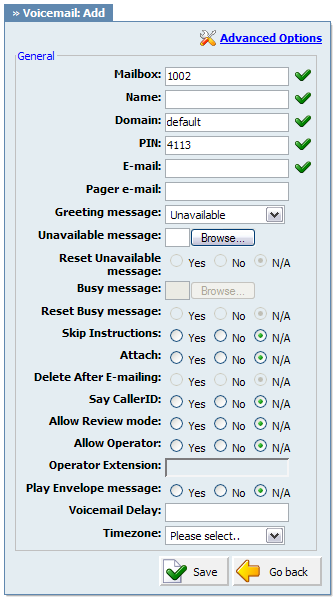
Add/Edit Voicemail |
Previous Top Next |
Clicking on 'Add Voicemail/Edit' Voicemail will open voicemail screen shown below.

Mailbox:
Unique network voice mailbox extension number
Example: Set this field to 5001 for example. Now, in order to dial into this voice mailbox, simply dial 5001 from any PBXware extension Field Type: [0-9]
|
Name:
Full name of voice mailbox owner
Example: John Smith Field Type: [a-z]
|
Domain:
Domain/Context this voice mailbox belongs to
Example: Advanced feature. Leave this field set to 'default' unless you are know what you are doing Field Type: [a-z][0-9]
|
PIN (Personal Identification Number):
Four digit number used for voice mailbox authentication
Example: Each voice mailbox has a unique PIN. In order to login to your voice mailbox, provide this number once asked for it by the operator e.g. 1947 Field Type: [0-9]
|
Email:
Email address associated with the voice inbox. This email is used for new voice message notification and audio file attachments
Example: If '[email protected]' is set here, once this mailbox receives a new message, notification and attached voice message (depending if this option is enabled) is sent to this email address Field Type: [a-z][0-9][@_-.]
|
Pager e-mail:
Provide the pager e-mail address here
Example: If '[email protected]' is set here, once this mailbox receives a new message, notification is sent to this pager email address Field Type: [a-z][0-9][@_-.]
|
Greeting message:
Greeting message played to uses before they are transferred to voice mailbox to leave the message
Example: Mailbox user may choose between 'Busy' and 'Unavailable' message Field Type: Select box
|
Unavailable message:
Upload the custom unavailable message. NOTE: Unavailable message supports: WAV, wav and gsm files only
Example: If the default unavailable message does not suit you needs, click the 'Browse' button, upload a custom message and select it under 'greeting message' Field Type: Select box
|
Reset Unavailable message:
Reset current unavailable message
Example: To reset current unavailable message click this button. NOTE: The message will be deleted from the filesystem Field Type: Option buttons
|
Busy message:
Upload the custom busy message. NOTE: Busy message supports: WAV, wav and gsm files only
Example: If the default busy message does not suit your needs, click the 'Browser' button, upload a custom message and select it under 'greeting message' Field Type: Select box
|
Reset Busy message:
Reset current busy message
Example: To reset current busy message click this button. NOTE: The message will be deleted from the filesystem Field Type: Option buttons
|
Skip instructions:
Skip the instructions telling users how to leave a voice message
Example: Once the caller reaches the voice mailbox, instructions on how to leave voice message are played. You are encouraged to set this option to 'Yes' all the time Field Type: Option buttons
|
Attach:
Should the voice message be attached and sent along with the notification email
Example: Caller leaves a voice message to John. With this option set to 'Yes', notification email John gets will have a voice message attached to it so John can listen to it without signing in to his voice mailbox Field Type: Option buttons
|
Delete After E-mailing:
Should the voice message sound file be deleted form the filesystem after sending it as an attachment to user's email address
Example: Caller leaves a voice message to John. With this option set to 'Yes', voice message will be deleted after sending it as an attachment to John's email address Field Type: Option buttons
|
Say CallerID:
Should extension number which left the voice message be announced to mailbox owner
Example: With this option set to 'Yes', John will hear '... from phone number 1004...' when checking mailbox, for example. Field Type: Option buttons
|
Allow Review mode:
Allow user to review his voice message before committing it permanently to voice mailbox
Example: After caller leaves the voice message and presses '#', additional review options are allowed: 1 to accept the recording, 2 to re-record your message etc... Field Type: Option buttons
|
Allow Operator:
Allow caller to reach the operator from the voice inbox by pressing '0'
Example: Once user leave a voice message and presses #, additional options, including '...press 0 to reach an Operator' are heard Field Type: Option buttons
|
Operator Extension:
Local extension number that is dialed once '0' is pressed to reach the Operator
Example: Once the caller leave a voice message to John and presses '0' to reach the Operator, extension number provided here (e.g. 1001) will be dialed Field Type: [0-9]
|
Play Envelope Message:
Announces date and time when the voice message was left in inbox
Example: With this option enabled, John will hear 'First message, 11:52, 02 Feb 2007' for example, when checking his voice mailbox Field Type: [0-9]
|
Voicemail Delay:
Delay time in seconds inserted before the Busy/Unavailable message is played to caller. This solves the 'half-played' file problem. Keep this value between 1-3
Example: Caller is to leave a voice message to John. It hears '...ot at home right now...'. Adding '1' to this field will add one second pause before the message is played. So, now new callers will hear the greeting message without the first part being cut off 'I am not at home right now...'. Field Type: [0-9]
|
Timezone:
Set the correct date and time format for message envelope. NOTE: Timezones are taken from '/usr/share/zoneinfo' system directory.
Example: Some countries prefer time format in mm-dd-yy or dd-mm-yy format. Select among the available options Field Type: Select box
|
Disk Space Used By Voicemail Recording:
With continuously tone 60 seconds:
With continuously silent tone (without sound) 60 sec:
|